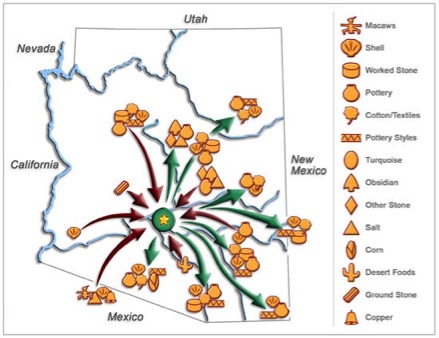Last updated: August 19, 2015
Lesson Plan
Trading to Survive at Tuzigoot

- Grade Level:
- Upper Elementary: Third Grade through Fifth Grade
- Subject:
- Literacy and Language Arts,Social Studies
- Lesson Duration:
- 90 Minutes
- Common Core Standards:
- K.SL.1, K.SL.2, K.SL.3, 1.SL.1, 1.SL.2, 1.SL.3, 1.SL.4, 2.SL.1, 2.SL.1.a, 2.SL.1.b, 2.SL.1.c, 2.SL.2, 2.SL.3, 3.RI.1, 3.RI.2, 3.RI.3, 3.RI.4, 3.RI.7, 4.RI.1, 4.RI.2, 4.RI.3, 4.RI.4, 4.RI.7, 5.RI.1, 5.RI.2, 5.RI.3, 5.RI.4, 5.RI.7
- State Standards:
- Arizona State Education Standards:
Social Studies: 4th grade
Strand 1, Concept 2: PO 2.
Strand 4, Concept 4: PO 4.
Strand 4, Concept 4: PO 5. - Thinking Skills:
- Remembering: Recalling or recognizing information ideas, and principles. Understanding: Understand the main idea of material heard, viewed, or read. Interpret or summarize the ideas in own words. Applying: Apply an abstract idea in a concrete situation to solve a problem or relate it to a prior experience.
Objective
What goods were traded and exchanged by Native American peoples near Casa Grande and Tuzigoot? What kind of economy existed in this region before money? How did people work and trade in order to survive?
Background
Different cultures surrounding Tuzigoot had different resources found in their regions, not found in other areas. In order to survive, everyone needed to trade products they produced to other Cultures who then traded for some of their products. Food and clothing were big trade items... but macaw parrots and turquoise jewelry too!
The region is a large desert. Different Cultures live in different regions of the desert. The Cultures have different resources found in their region which is not found in other areas. In order to survive, they need to trade products they produce to other Cultures who will then trade for some of their products.
Point out to students the abundance of agricultural products may change from year to year based upon drought or a rainy season (surplus and shortfall). The Cultures then have control over these resources.
Preparation
Readings can be used as articles for higher grades (grades 3-5) or they can be read-aloud for students in grades (K-2). Native American studies are commonly in curriculums for grades Kindergarten and 4th grade.
Print readings and trading cards. Read lesson plan as a guide and decide which readings and activities fit best with your classroom and curriculum.
Materials
Download Readings for Teacher Read Aloud or Student Guided Reading
Lesson Hook/Preview
Pre-Activity for Trading and Detective Scavenger Hunt
Go to the Tuzigoot National Park website and view the virtual tour (computers will need QuickTime installed to navigate the QTR 360° images which reflect the text below them) found at www.nps.gov/tuzi/photosmultimedia/virtualtour.htm to give students some background information about the area and what is to be expected.
Discuss with students how sometimes they trade objects (lunch items, stickers, baseball cards, toys) with one another and why they do this. Ask them to imagine trading for survival and what kinds of things they may need/want to trade today in order to survive (no money to purchase anything). If that concept is hard for them to imagine, try asking them what their favorite dinner or dessert is. Then tell them that the only way to get that food is by trading something with their neighbor. What would they be willing to part with to get that food?
Procedure
Trading to Survive: Native People at a Market Place
Discussion
Discussions focus on the various products obtained by the different Native People based upon their environment. Also discuss the necessity of trading products to survive (needs vs. wants and what if there was a drought).
Activity
Ranger or teacher will briefly tell students the background information on trading and its purpose. (see readings)
Trading cards with pictures and names of the product will be passed out to students. They will look on the Cultures People Posters (or make a 4 box Anchor Chart) for information on which nation produced what kind of product. Students will place their trading cards by the correct poster. Once all cards have been placed, the students will count off 1-4 for placements into groups.
Each group will take a poster and its trading cards to a designated area. The groups will be given a couple of minutes to discuss among themselves their strategy for what products they need to obtain and how much of their product they would be willing to trade away.
The Ranger would then call on one group at a time to go to the other Cultures to trade. Once all the trading has taken place the Ranger would call on each nation to explain their choices.
Optional (if time allows): Ranger will reset the trading cards and tell the groups that one area has had a drought (or a surplus) and have the groups trade a 2nd time with the new environmental factors in mind.
Vocabulary
Sinagua, Tuzigoot, Montezuma Castle, montezuma well, southern sinagua, trade, prehistoric, barter, economy, shortfall, surplus, competition, Market place, Drought, Cotton, Obsidian, Amaranth, Pit house, Casa Grande
Additional Resources
A Brief History of the Casa Grande Ruins
Learn about the Lower Cliff Dwelling
Learn about the Upper Cliff Dwelling
Learn about People
Learn about Places
Learn about Stories
For more information, see "Casa Grande Ruins Centennial History, 1892-1992." (1.72 MB PDF file) More historic documents can be found at the National Park Service History website:
https://www.nps.gov/history/history/park_histories/index.htm#cagr.
